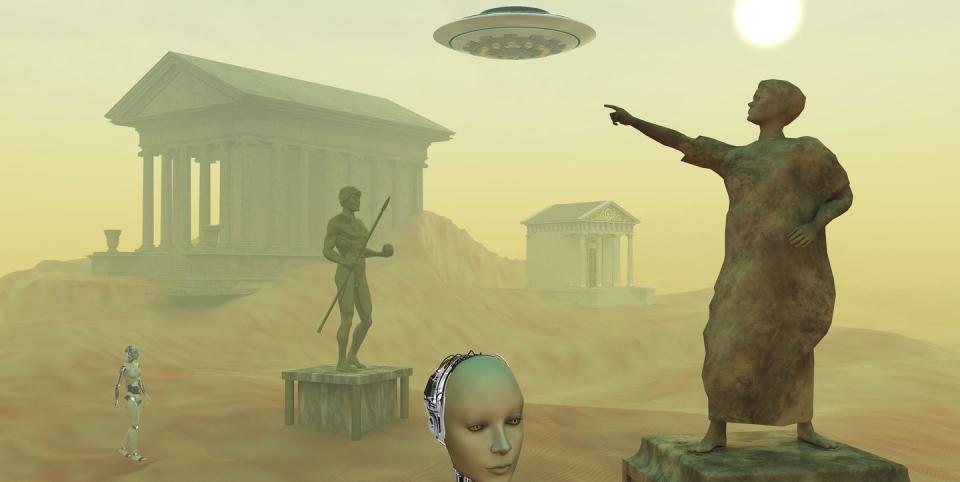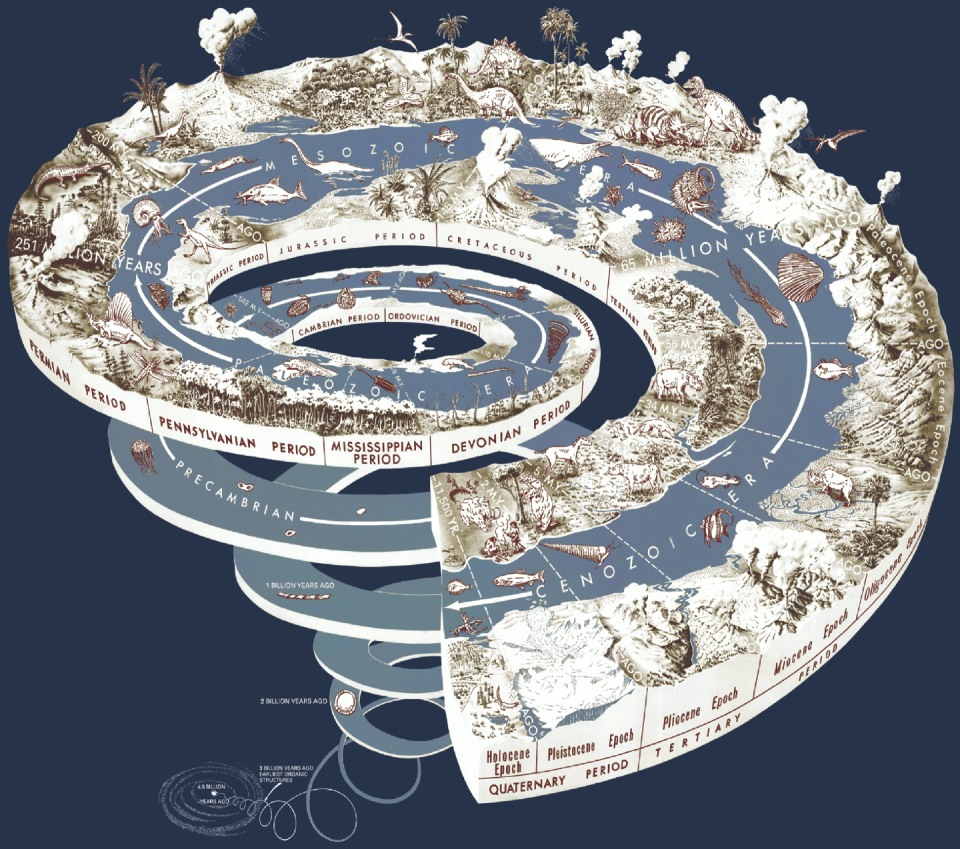Scientists Want to Know If Earth Once Harbored a Pre-Human Industrial Civilization

The Silurian hypothesis asks whether it might be possible to find evidence of a pre-human industrial civilization in Earth’s geologic record—even one that might have existed millions of years ago.
The astrobiologists who developed the thought experiment concluded that there is not strong evidence in Earth’s geologic record to support such a claim.
However, we still lack the scientific methods that would allow us to dive deep into Earth’s behaviors over such a long time span, so we may want to keep an open mind.
Complex life on our planet has existed for at least 400 million years. Yet as a species, we only managed to create an industrial civilization around 300 years ago. But, what if an earlier industrial civilization existed on Earth millions of years ago? If that were so, how would we be able to prove it—or disprove it? This is the crux of the Silurian hypothesis, a fascinating thought experiment that appeared in a study published in 2018 in the International Journal of Astrobiology.
The possibility of life elsewhere in the universe and its parallels with the Anthropocene—the current geological epoch, during which humans have impacted Earth to the point of no return—has long puzzled Adam Frank, a professor of astrophysics at the University of Rochester, New York, and one of the two authors of the study.
🔭 Science explains the world around us. We’ll help you make sense of it all—join Pop Mech Pro.
“Is it common for any civilization that reaches our level of energy use to trigger their own version of climate change? I was wondering. If there are alien civilizations, would they also trigger climate change?” Frank ponders. With this whirlwind of thoughts in mind, Frank visited the NASA Goddard Institute of Space Sciences (GISS), an elite climate-science facility at the University of Columbia, New York. He wanted to share his thoughts with climate researchers, and surely expected lots of raised eyebrows and skeptical stares in the process.
“I went into the meeting with Gavin A. Schmidt [a climatologist and the director of NASA GISS], and started talking about aliens. And then Gavin stopped me and said, ‘Wait a second. How do you know we’re the only time there’s been a civilization on our own planet?’’’Frank tells Popular Mechanics. The question was an “Aha!” moment for Frank, mostly because it allowed him to consider revisiting facts he had taken for granted.
Evidence in Earth’s Geologic Record

Homo sapiens first appeared on Earth about 300,000 years ago. In the unlikely case that such an old industrial civilization had existed, it would predate the species to which we all belong. It was then that Schmidt called the idea the Silurian hypothesis, paying homage to the sophisticated reptilian humanoids awoken by nuclear testing after 400 million years of hibernation in a 1970s episode of the British science fiction television series Doctor Who. The study authors decided to laser in on the time period from four million years ago to 400 million years ago.
Going back hundreds of millions of years to find traces of a potential pre-Homo Sapiens civilization is not a piece of cake. “After a few million years, Earth is pretty much resurfaced. You’re not going to have any statues, buildings, or anything left,” Frank says. Fossil records will be virtually nonexistent as everything will have crumbled to dust. The only evidence would come in the form of chemical imprints. “You’d have to look at each layer of rock, and then try and detect trends—look for changes in things like the carbon or oxygen isotopes, which are tracers of things like carbon dioxide. An industrial civilization would dump lots of carbon dioxide into the atmosphere, just like we do,” Frank says. Plastic or nanoparticles would also be good indicators of an industrial civilization that occurred in time immemorial.
Schmidt and Frank were intrigued by the period of geological history known as the Paleocene-Eocene Thermal Maximum (PETM), because something peculiar happened on our planet during it, 56 million years ago: Earth’s average temperature soared to 15 degrees Fahrenheit above what we have today, and the world became a temperate and iceless place. They investigated the carbon and oxygen isotope ratios from the PETM and indeed saw spikes, but they also saw declines, and all of these over a few hundred thousand years, which is nowhere near the speed at which carbon is currently suffocating the atmosphere. Frank says the PETM’s chemical differences pointed to a long-term climate change.
They also reviewed other “abrupt events” throughout time that are visible in the geologic record, including ocean anoxic events—when an ocean becomes depleted of oxygen—and extinction events. Unsurprisingly, and perhaps slightly disappointingly, they were not indicative of an industrial civilization, either.
Applying Occam’s Razor
“The hypothesis that Earth may have harbored long-extinct industrial civilizations and that existence may be recorded in the geologic record associated with climate change signatures is fascinating, however, even the authors are not sold on the likelihood of it being true,” Stephen Holler, an associate professor of physics at Fordham University in New York City, tells Popular Mechanics.
A great rule of thumb exists in science, and it goes by the name Occam’s razor. In the 14th century, English Franciscan philosopher and theologian William of Ockham proposed that the likeliest solution to a problem is the simplest one. “That is very likely the case here,” says Holler. “We can largely explain the geologic record in terms of natural phenomena, so there is no need to invoke lost civilizations.”
However, if an earlier industrial civilization did exist, and its extinction was the result of catastrophic climate change due to industrial activities, then we should heed the warnings because, as a civilization, we stand at the precipice. “It will be a hard landing when we go over the edge, and we very well might not survive,” says Holler.
Greater Sustainability Leads to Fewer Signs
There is an oxymoron to the Silurian hypothesis: the more sustainable a society is in the way it generates energy and manufactures resources—arguably, the more advanced a society is—the smaller the footprint it will leave on the planet. Yet, this smaller footprint would translate to few markers on the geologic record for that period. For example, the more plastic or persistent synthetic molecules we produce, the higher the chances future civilizations will find traces of us. (Our society produces 300 million tons of plastic each year worldwide—almost the equivalent of the weight of the entire human population!). Even if we wipe ourselves off the face of Earth with a nuclear catastrophe, long-lived radioactive particles will endure in the soil eons later, signaling we had existed.
“With the Silurian hypothesis, we articulated the kinds of signals that our civilization would leave if we disappear and somebody looks for our civilization 10 or 20 millions of years from now,” Frank says.
But most of all, the experiment demonstrated certain shortcomings in our current scientific apparatus. “In case an earlier species’s industrial activity was particularly short-lived, we would not be able to detect it in ancient sediments with the tools and methods we have now,” Frank explains. “If you want to look for evidence of a previous civilization, you’d have to do studies that nobody’s done and develop novel methods—for example, you’d have to figure out ways to look at the rock record on a much finer timescale.”
Remember, we are talking about millions of years of evolution of complex life and an unsparing Earth that grinds down everything in its wake. And though both Frank and Schmidt don’t really believe an industrial civilization existed before our own, the main takeaway of the Silurian hypothesis, Frank says, is that if you’re not explicitly looking for something, you might not even see it.
You Might Also Like
